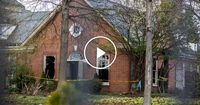In a case that has rattled Pennsylvania’s political core and reignited national debate on the safety of elected officials, Cody Balmer, 38, pleaded guilty on October 14, 2025, to a litany of charges stemming from his arson attack on Governor Josh Shapiro’s official residence. The attack, which occurred in the early hours of April 13, 2025, left the governor’s mansion in Harrisburg badly damaged but, miraculously, resulted in no injuries. Still, the incident has left deep psychological scars on the Shapiro family and has become a chilling symbol of the rising tide of political violence in the United States.
According to NPR, Balmer admitted in Dauphin County Court to attempting to murder Governor Shapiro, as well as to terrorism, 22 counts of arson, aggravated arson, burglary, aggravated assault, 21 counts of reckless endangerment, and loitering. In a plea deal that avoided a lengthy trial, Balmer was sentenced to 25 to 50 years in prison—a term both severe and, as his defense attorney Bryan Walk noted, a “hefty price for a man who’s 38 years old.” Balmer declined to address the judge about his actions, responding to questions with short, simple answers.
Security camera footage played in court and described in The New York Times showed Balmer scaling the iron fence surrounding the governor’s mansion under cover of darkness. He broke a window, hurled a Molotov cocktail into a dining room often used for entertaining, and then used a small sledgehammer to shatter another window and crawl inside. The video, which Judge Deborah Curcillo called “horrific” and “very frightening,” captured Balmer progressing far enough into the residence to kick at doors leading to the sleeping quarters of Governor Shapiro and his family. Unable to breach those doors, he set a second fire before leaving the scene, all without encountering the state police stationed on the property.
Shapiro, his wife Lori, their children, and several guests were inside the mansion at the time. They were awakened and evacuated as the fire spread, but, as fate would have it, no one was physically harmed. The multiple arson and endangerment charges reflected the number of people in the residence, including state troopers. The fire, however, caused millions of dollars in damage to the stately brick building, which was constructed in 1968 and, notably, lacked a sprinkler system. The flames charred walls, tables, buffet serving dishes, plates, and a piano. Window panes and bricks around doors and windows were also destroyed, and restoration efforts are ongoing to both repair the damage and bolster the mansion’s security.
In a victim statement read in court, the Shapiros described the aftermath as leaving them “exposed in unimaginable ways,” and spoke of “a fear and anxiety we are learning to live with.” At a news conference following the plea, Governor Shapiro reflected on the broader implications of the attack. “Why would someone want to do us harm, our kids will ask. How were they able to get so far into the governor’s residence, a place that is supposed to be the safest place we could possibly be?” he said, according to NPR. He emphasized that political violence should not be accepted as the norm for public servants and noted he had been contacted by leaders around the world expressing their own fears and concerns about rising hostility toward politicians.
The attack came just hours after the Shapiro family had celebrated the Jewish holiday of Passover with a Seder at the residence, raising speculation about possible anti-Semitic motives. However, in a May letter from jail to the Associated Press, Balmer dismissed this notion. “He can be Jewish, Muslim, or a purple people eater for all I care and as long as he leaves me and mine alone,” Balmer wrote, distancing himself from targeting Shapiro for his faith.
Still, questions about Balmer’s motivation linger. During interviews with police, Balmer cited concerns about the death toll in the ongoing war in Gaza, suggesting he saw his actions as some kind of offset. As reported by NPR, his comments indicated a willingness to take a life for what he viewed as a political cause. In a brief video interview from Camp Hill State Prison in June, Balmer said he had considered the risk to children before acting. “Does anyone ever consider children? It doesn’t seem that way. I sure as hell did. I’m glad no one got hurt,” he said. When pressed on why he felt Shapiro had wronged him, Balmer simply replied, “I’m not going to answer that.”
Balmer’s mental health history became a focal point throughout the proceedings. His mother told reporters she had tried to get him help for his mental health issues but “nobody would help.” Court proceedings were delayed as Balmer underwent treatment, and a letter from his relatives read in court described how he had stopped taking his medication, leading to manic episodes and a “dark and difficult path.” Balmer, an unemployed welder with no income or savings and “a lot of children,” according to his own statement to a judge, ultimately turned himself in to authorities the afternoon after the attack.
Prosecutors relied heavily on security footage to make their case. As The New York Times reported, the video was a key piece of evidence, showing Balmer’s methodical movements and the terrifying reality of how close he came to confronting the governor and his family. District Attorney Fran Chardo noted that Balmer told police he planned to beat Governor Shapiro with the sledgehammer if he had encountered him inside the mansion.
The attack on Governor Shapiro’s residence is not an isolated incident but part of a troubling national pattern. In recent years, political violence has escalated, with elected officials across the spectrum facing threats to their safety. Shapiro himself has spoken out against what he calls the “rhetoric of rage” that has become increasingly common in American political discourse. Days before the plea hearing, he referenced the assassination of conservative activist Charlie Kirk and condemned those who normalize or incite violence for political ends.
The plea deal, which Shapiro and his family supported, was intended to provide “real accountability,” in the governor’s words. For now, work continues to restore the damaged mansion and to strengthen its security. But the psychological impact on those targeted—and on the broader political community—remains profound. The incident has prompted renewed calls for vigilance, compassion, and a return to civility in public life. As Shapiro noted, it is an “ongoing effort” to reassure his children and to help them—and, by extension, the public—feel safe again.
The events in Harrisburg serve as a stark reminder that the safety of public officials cannot be taken for granted. As political tensions continue to simmer nationwide, the hope is that this case will spark meaningful reflection and, perhaps, real change in how society confronts and prevents political violence.




